
Slow, enormous waves that move beneath the ocean surface have intrigued researchers for a century. These “internal waves” affect the world’s deep seas in many ways, but they’re hard to observe.
Internal waves play a major role in mixing the ocean’s water. Global climate models need to account for this mixing because it warms the deep sea and cools the ocean surface. Internal waves also move seafloor sediment and nutrients, affecting fisheries and coral reefs. And underwater operations, from oil drilling to submarine missions, need data on the deep-sea “weather” of turbulence and disturbances that internal waves produce.
A new paper giving the first “cradle-to-grave” explanation of the world’s strongest internal waves was published this week in the journal Nature. It’s a major step forward in ocean science.
Physics explains how ordinary waves, known as gravity waves, behave in water. The same physics permits gravity waves to form inside the sea wherever two layers of different water density meet. To see an everyday example, take a bottle of salad dressing, with oil on top and vinegar underneath. Instead of shaking the bottle, tilt it gently and watch the internal waves between the oil and vinegar.
The ocean has many places where internal waves happen. All that’s needed is two layers of water with different density. For instance, where rivers pour fresh water on top of denser seawater, internal waves can form on the hidden surface of the seawater. In the Arctic Ocean, melting ice can spread a calm layer of fresh water as the salty sea continues to roil beneath it.
